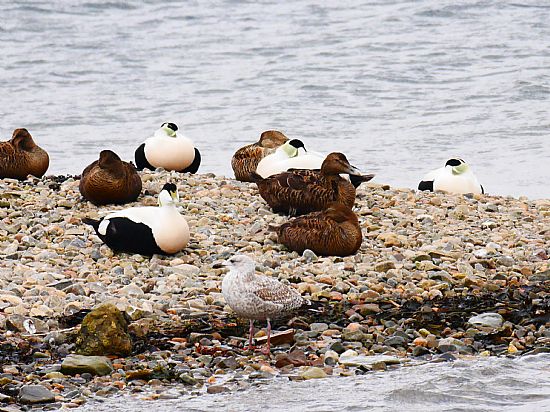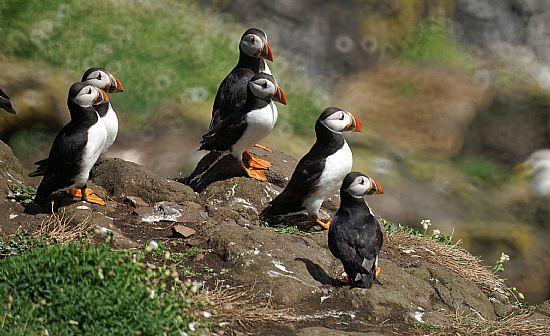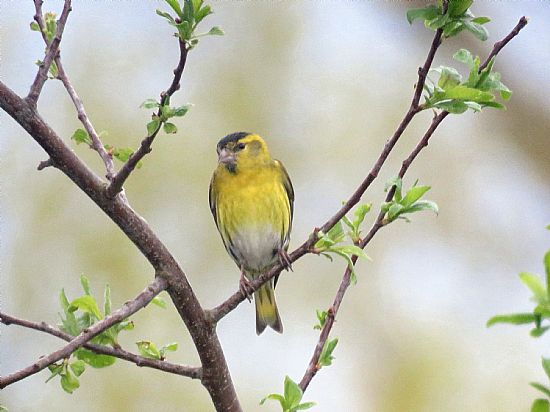Scottish Highlands, April 2025
Mark Finn
April 18-23
April 18th: Portsoy, Cullen, Loch Spynie, Lossiemouth
Daily 61 New 61 Running 61
Weather: Sunny with a cool NE wind 12c
Our tour started in the village of Portsoy which is situated in the county of Aberdeenshire. The harbour area is good for birds and we quickly located Rock Pipit, Northern Fulmar, Northern Gannet, Herring and Common Gulls. No sign of loons on the sea so I headed toward Loch Spynie near Lossiemouth a reserve overlooking a shallow loch fringed with reedbeds. The feeders by the car park were productive for the commoner woodland birds whilst the track towards the hide added Willow Warbler and Common Chiffchaff. The hide is new and offers views over the loch where we located Pink-footed and Greylag Geese, Mute Swan, Northern Shoveler, Gadwall, Eurasian Teal, Tufted Duck and Little Grebe. I ended the day with a visit to Lossiemouth pig farm where a Little Ringed Plover was seen by a large rock. In addition to this scarce bird the group added Great and Lesser Black-backed Gulls and Eurasian Wigeon.
Mammals: Red Squirrel (2), Brown Hare (1)

Common Eiders
April 19th: Portmahomack, Tarbatness, Embo, Loch Fleet, Brora, West Langwell, Novar Estate
Daily 68 New 22 Running 83
Weather: Rather mixed with an E wind 10c
A review of the weather conditions meant a change of direction from the west coast towards the east. The feeders at Cygnus House held the common garden birds plus sightings of Eurasian Tree Sparrow and Yellowhammer. Portmahomack is a small community in Easter Ross which attracts the arty set and nature lovers. A scan of the bay quickly revealed the presence of Red-throated Loons, Common Scoter, Long-tailed Duck and Common Eider. Also present were gulls, Great Cormorant and European Shags. Tarbatness has the third highest lighthouse in the UK and a habitat of scrub, grassland and cliffs. In the car park close views of Song Thrush, Dunnock, Meadow Pipit, Willow Warbler and Reed Bunting. It was time to move on towards the village of Embo via Dornoch the county town of Sutherland. At Embo the rocky shore held a large flock of Purple Sandpipers a real bonus of a declining shorebird. At The Mound the returning Ospreys showed well in addition to Red-breasted Mergansers, Common Sandpiper and Eurasian Teal. Further north we made a visit to Brora where Common Redshanks were building on their northward migration, Sandwich Terns resting on rocks and Sand Martins feeding over the sea. A diversion inland in the Brora Valley had a Golden Eagle being mobbed by a Common Kestrel. At West Langwell the resident Whooper Swans were still around plus a steady increase of Northern Wheatears. Novar Estate was our final birding spot which today produced little of interest.
Mammals: North Atlantic Grey Seal (c), Brown Hare (3), Eurasian Badger (1)
April 20th: Strathpeffer, Achanalt, Kinlochewe, Gairloch, Loch Ewe, Laide, Gruinard Bay
Daily 72 New 12 Running 95
Weather: Sunny with a cool NE wind 13c
The weather forecast was better today for the west coast. Our first stop was the shallow lochans near Strathpeffer where we located up to four pairs of Horned Grebes, Little Grebe and Tufted Ducks. Our route took us towards the hamlet of Achanalt a remote place with a railway station and little else. From a view point we located an adult White-tailed Eagle perched on a large log. A careful scan of the loch added Whooper Swan, Back-throated Loon, Tufted Duck, Common Sandpiper, Common Redshank and a pair of European Stonechats. The gardens at Kinlochewe can be productive for birds and toady we were delighted to view a pair of Eurasian Bullfinches at close range feeding on the buds of a fruiting tree. Gairloch was next a mainly Gaelic speaking village. In the bay we made the first sightings of Common Loons, Red-breasted Mergansers and a single Ruddy Turnstone looking for food among the rocky foreshore. Loch Ewe was quiet today apart from a pair of European Whimbrel and Ringed Plovers. Time was getting on as I pulled into the lay-by overlooking Gruinard Island. A Common Cuckoo was calling and giving us the run around and a party of European Golden Plovers feeding on a grass field.
Mammals: North Atlantic Grey Seal (1), Common Rabbit (20)

Atlantic Puffins
April 21st: Cromarty Firth, Udale Bay, Forsinard, Sandside Bay, Scrabster Harbour, Dunnet Bay, St John’s Loch, Dunnet Head
Daily 74 New 9 Running 104
Close to Cygnus House is the Cromarty Firth and I visited the deeper waters in search of birds. Just beyond Jemimaville we located a large group of Greater Scaup with smaller numbers of Long-tailed Duck, Common Eider, a single Horned Grebe and Red-breasted Mergansers. At the hide the grass attracted White and Pied Wagtails, Pink-footed Geese and the common ducks. It was time to head north with a visit to Forsinard via Glen Loth a remote road running through moorland. Along the road Mistle Thrush was encountered along with Meadow Pipit and European Stonechat. At Forsinard we were treated to a skydiving male Hen Harrier and displaying Common Snipe. Sandside Bay had a few birds but I pressed on to Scrabster Harbour which held Common Eider, Common Murre, Black Guillemot and many juvenile Great Black-backed Gulls. Dunnet Bay held a flock of Long-tailed Ducks and Sandwich Terns. A detour to St John’s Loch added nothing of note so it was on to Dunnet Head the most northerly point of mainland Britain. The cliffs here added Great Skua, Razorbill and Atlantic Puffin.
Mammals: Red Deer (10), Common Rabbit (c)
April 22nd: Sandside Bay, Bettyhill, Durness, Ullapool
Daily 72 New 3 Running 107
Weather: Sunny with a SE wind 14c
After our night in Thurso I went west towards Sandside Bay for a brief stop where we managed to see the alpine race of Dunlin on the beach. Bettyhill has a picturesque beach where the commoner birds were located and after this the journey to Durness the most north-westerly village in the UK. Our main interest was the water meadow at Balnakiel an important place for birds and literally the last field in Scotland. Species we encountered in the marsh included Common Moorhen, Common Coot, Gadwall, Northern Shoveler, Eurasian Wigeon, Whooper Swan and Little Grebe. The grass fields were alive with migrating Meadow Pipits, Eurasian Skylarks and White Wagtails. After this spectacle I went south towards the port of Ullapool and onto the Black Isle.

Eurasian Siskin
April 23rd: Corrimony, Ness Islands, Nethybridge, Loch Garten, Findhorn Valley
Daily 51 New 7 Final 113
Weather: Rather mixed with a SW wind 13c
Corrimony was first up one of the best places to see Black Grouse in the UK. Alex is the warden here and we made our way to the first lek where the grouse were displaying in top form. In total we managed to see around 28 birds of this rather special bird. Back to Cygnus House for breakfast and then a visit to Ness Islands in Inverness. This is a popular place for local people and a great place for birding. A slow walk added Eurasian Treecreeper, Eurasian Bullfinch, Eurasian Siskin and Common Merganser on the river. Nethybridge was next on our agenda with the river holding a pair of Common Goldeneye, hirundines and a flight view of White-throated Dipper and a male Grey Wagtail. We dropped into the visitor centre at Loch Garten which has sadly seen better days. Our last birding spot was the Findhorn Valley where Red Kites were the common bird of prey. In the fields we watched Northern Lapwing, European Golden Plover, Eurasian Curlew, Black-headed and Common Gulls. Back to the Black Isle via the Farr Road which is sadly very poor for birds with extensive wind farm development and deer fences.

